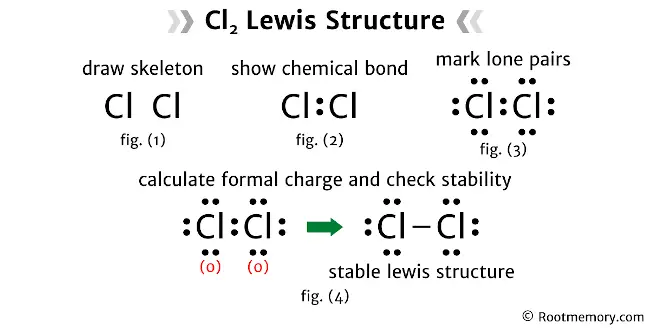
The Lewis structure of Cl2 contains a single bond between the two chlorine atoms, and each chlorine atom has three lone pairs.
Alternative method: Cl2 Lewis structure
Steps
Draw skeleton
In this step, first calculate the total number of valence electrons. And then, decide the central atom.
- Let’s calculate the total number of valence electrons
We know that… chlorine is a group 17 element. Hence, chlorine has seven valence electrons.
Now Cl2 has two chlorine atoms.
So the total number of valence electrons = valence electrons of chlorine atom × 2
Therefore, the total number of valence electrons = 7 × 2 = 14
- Now decide the central atom
There are two chlorine atoms in Cl2. Hence, we can assume any one as the central atom. Let’s assume that right chlorine is the central atom.
So now, put two chlorines next to each other. And draw the rough skeleton structure for the Lewis structure of Cl2 something like this:

Also read: How to draw Lewis structure of COCl2 (5 steps)
Show chemical bond
Place two electrons between the atoms to show a chemical bond as follows:

Also read: How to draw Lewis structure of BH3 (3 steps)
Mark lone pairs
As calculated earlier, we have a total of 14 valence electrons. And in the above structure, we have already used two valence electrons. Hence, twelve valence electrons are remaining.
Two valence electrons represent one lone pair. So twelve valence electrons = six lone pairs.
Note that chlorine is a period 3 element, so it can keep more than 8 electrons in its last shell.
Also, make sure that you start marking these lone pairs on outside atoms first. And then, on the central atom.
The outside atom is left chlorine, so left chlorine will get three lone pairs. And the central atom (right chlorine) will also get three lone pairs.
So the Lewis structure of Cl2 looks something like this:

In the above structure, you can see that the octet is completed on the central atom (right chlorine), and also on the outside atom. Therefore, the octet rule is satisfied.
After completing the octet, one last thing we need to do is, calculate the formal charge and check the stability of the above structure.
Also read: How to draw Lewis structure of NCl3 (4 steps)
Calculate formal charge and check stability
The following formula is used to calculate the formal charges on atoms:
Formal charge = valence electrons – nonbonding electrons – ½ bonding electrons
Collect the data from the above structure and then, write it down below as follows:
- For each chlorine atom
Valence electrons = 7
Nonbonding electrons = 6
Bonding electrons = 2
Formal charge = 7 – 6 – ½ (2) = 0
Mention the formal charges of atoms on the structure. So the Lewis structure of Cl2 looks something like this:

In the above structure, you can see that the formal charges of both chlorines are zero. Therefore, this is the stable Lewis structure of Cl2.
And the horizontal line drawn in the above structure represents a pair of bonding valence electrons.
Next: Lewis structure of COCl2
Related
- Lewis structure of COCl2
- Lewis structure of BH3
- Lewis structure of NCl3
- Lewis structure of BrF5
- Lewis structure of BrF3
External video
- Cl2 Lewis Structure – How to Draw the Dot Structure for Cl2 – YouTube • Wayne Breslyn
External links
- Cl2 lewis structure, Molecular shape, Polar or Non-Polar, Dot diagram – Topblogtenz
- Cl2 Lewis Structure in 6 Steps (With Images) – Pediabay
- What is the Lewis structure for Cl2? – Homework.Study.com
- Chlorine (Cl2) Molecule Lewis Structure – Chemistry School
- Cl2 Lewis Structure, Geometry, Hybridization, and Polarity – Techiescientist
- Chemical Bonding: Cl2 Lewis Structure – The Geoexchange
- How to draw Cl2 Lewis Structure – Science Education and Tutorials
- Draw the Lewis electron structure for the Cl2 molecule – Chegg
- The covalent bonding in the chlorine molecule – Doc Brown’s Chemistry
- How do you determine the Lewis Structure of Cl? – Quora
Deep
Rootmemory.com was founded by Deep Rana, who is a mechanical engineer by profession and a blogger by passion. He has a good conceptual knowledge on different educational topics and he provides the same on this website. He loves to learn something new everyday and believes that the best utilization of free time is developing a new skill.
